The Russian-Ukrainian War, Part III
We ended Part II of this series with one of the foremost military strategic thinkers declaring that Russian forces are…in a classic example English understatement… “in a bit of a pickle”. What could possibly explain the idea that great Russian Bear, the conquerors of the Wehrmacht, the terrors of the Cold War, the second most powerful military on earth could be “in a bit of a pickle”? Lets look at the some “relatively” recent history for some clues for the size of the pickle barrel.
In 1991 the USSR, the Union of Soviet Socialist Republics, broke up and its 15 former soviet socialist republics became independent countries. Some of these former soviet socialist republics joined the EU and NATO (Latvia, Lithuania and Estonia), others remained closely allied with Russia (Belarus, Armenia) and others took different economic, political and military paths to one degree or another. More on that later.
Russia refers to the 1990s as the “Dismal 90’s” which were to have profound effects on the future of Russia which would in turn have dramatic effects on the future war with Ukraine.
Macro Economics of the Dismal 90’s
As the largest constituent state of the former Soviet Union, Russia was most seriously affected by its dissolution. GDP per capita is a crude measure of economics but it is an important one. Here is a chart:
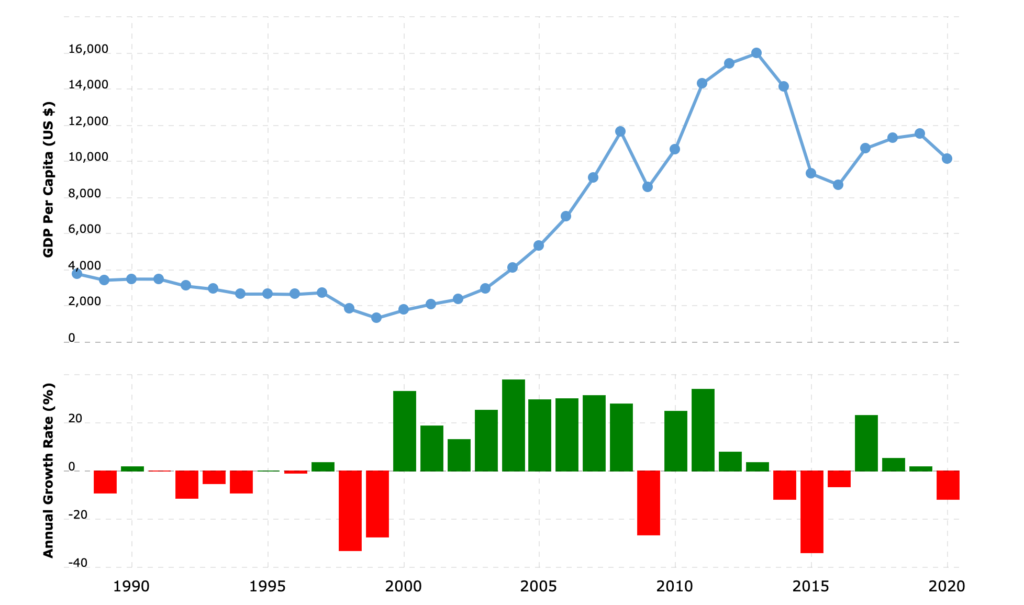
Source: macrotrends.net
You may be asking, “So what, Russian got poorer from 1990 to 2000. But look how they rebounded! They must have lots of money now. Why does this have anything to do with the Ukraine?
The answer is simple, economic well being is one of the largest drivers of birthrate in a “modern” country. Birthrate is a critical driver demographics. If well educated young mothers, and Russia has one of the highest literacy rates and one of the highest education rates in the world, are not economically secure they will reduce the size of the family.
Demographics, to a significant degree, drives destiny.
Birthrate and Dismal 90’s
Birthrate, like GDP for economics, is a crude measuring stick for determining demographics but it is an important one. Lets have a look:
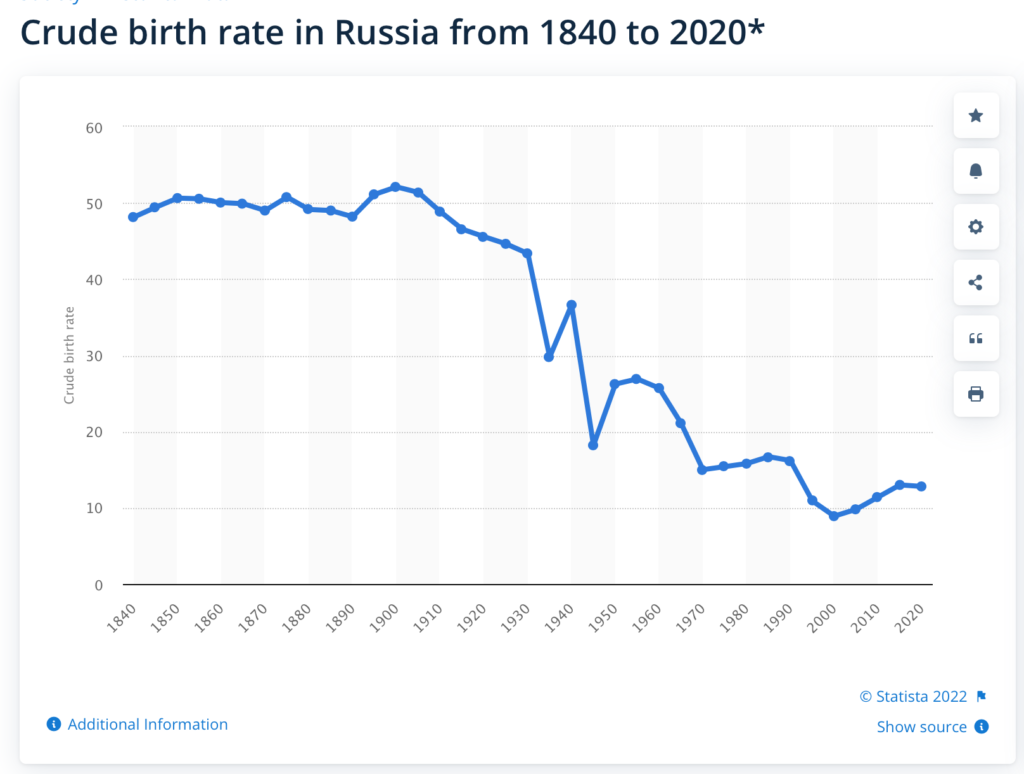
Source: statista.com
What is interesting about this particular chart is it shows a very high birthrate from 1900 to 1930 which shows a very high availability of people in the military age demographic (18-40) for Russia in World War II. The Soviet Union was famous for its human wave attacks in WWII where objectives were taken despite huge losses in soldiers, mostlybut not exclusively… young men. The crude birth rate suggests that the USSR could “afford” to recklessly and wildly “spend” (some would use the term waste) the lives of young Russians to achieve victory at all cost between 1940 and 1945. The crude birth rate data also points out that the heirs to the USSR, the Russian Federation, cannot afford to recklessly and wildly “spend” (some would use the term waste) lives of its young men on victory at all cost because these young men simply do not exist to spend in 2022 as these young men were never born.
Birthrate is an important factor, but it is not the only factor. Let’s take a look at immigration and emigration.
Immigration and Emigration and the Dismal 90s
Russia was the largest constituent republic in the Soviet Union. While on “paper” all Soviet Socialist Republics were equal, reality dictated otherwise and in true Orwellian fashion, some socialist states were more equal than others. As such Russians dominated the politics, economics and military of the USSR. Russia had the most to lose and the farthest to fall. This affected the demographics of Russia in two important ways.
Emigration: Russians left Russia to seek new lives and opportunities elsewhere. Many over to the United States, western Europe and Israel due to the bad economy, the unpopular war in Chechnya, and the perception (if not reality) of a chance for a better life.
Immigration: While the lives of Russians in Russia had the furthest to fall, the lives of Russians in former Soviet Republics had the shortest distance to fall before life became unbearable. In some former Soviet Socialist Republics Russians were heavily discriminated against. In others, the standard of living fell to the point that the Russian Federation with all its problems with the economy and political instability (next point below) were a welcome improvement to the decline of standard of living in former soviet socialist republics where they may have lived for multiple generations.
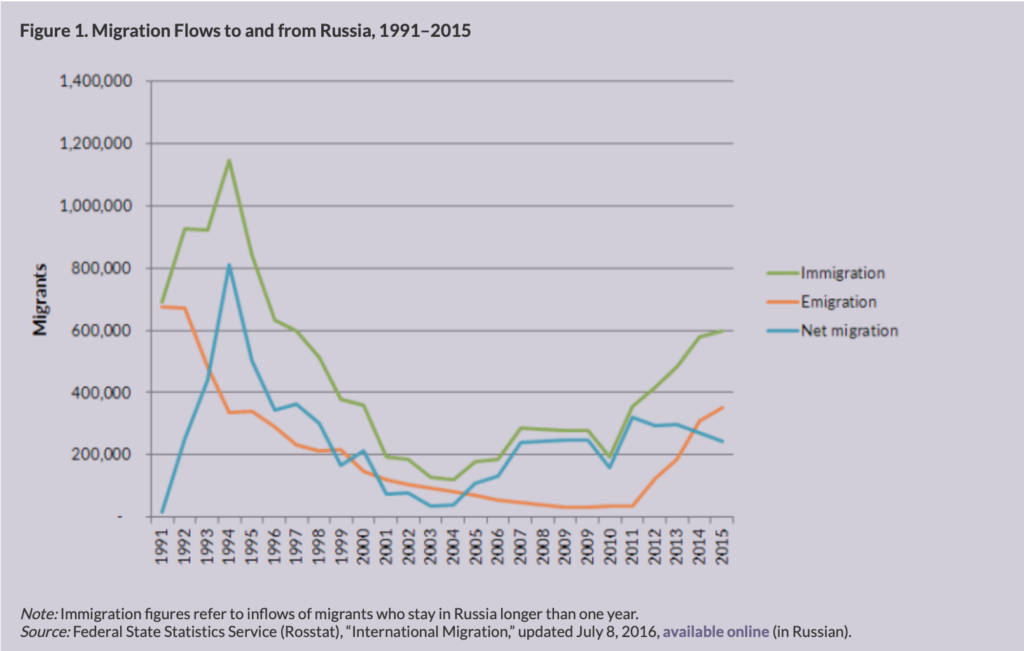
While the immigration to Russia offset the population losses due to emigration from Russia in most years, the net population growth due to migration in the critically important years of 200-2005 were smaller than previous years Why are these years important you may ask? Ethnic Russians who emigrate abroad in these years will not bear children of prime military age for the Russian military in 2022.
Political Instability and the Dismal 90s
Russia had two “official” coups and one “unofficial coup” in the Dismal 90’s. All contributed to the societal sense of uncertainty and general unease of the population.
1991 Soviet Coup D’état Attempt
The 1991 Soviet coup d’état attempt (August Coup) was an attempt to remove from power the government of Mikhail Gorbachev, Soviet President and General Secretary of the Communist Party of the Soviet Union, by Soviet hardliners including the leadership of the KGB and some elite units of the Soviet Army. The Soviet hardliners, KGB and Army were unhappy with the dissolution of the Warsaw Pact and fearful that the New Union Treaty that was about to be signed would go too far in reducing the central government‘s power relative to the 15 Soviet Socialist Republics.
Russia’s most elite special operations forces, the Alpha Group and the Vympel Group, arrested Gorbachev and others but failed to arrest recently elected reformist Russian SFSR president Boris Yeltsin. The elite “Taman Guards” 2nd Guards Motor Rifle Division and Kantemir 4th Guards Tank Division assumed positions at all key government buildings in Moscow. Tanks of a single tank battalion of the elite “Taman Guards” 2nd Guards Motor Rifle Division surrounded the White House, the seat of the power for the Russian SFSR.
The reformist cause looked doomed when the actions of a single man changed changed the course of history on August 19, 1991. Major Sergey Yevdokimov, chief of staff of the tank battalion of the elite “Taman Guards” 2nd Guards Motor Rifle Division surrounding the White House, declared his loyalty to the Russian SFSR. The tanks of the elite “Taman Guards“, repositioned to take position supporting the defense of the White House. Boris Yeltsin, the newly-elected “reformist” President of the Russian SFSR, stood atop tank No. 110 of the “Taman Guards” to deliver the famous “tank speech” (video) that would catapult Yeltsin on to the world stage ensuring that he eclipse a fading and increasingly ineffectual Mikhail Gorbachev. It was literally, a speech heard ’round the world.
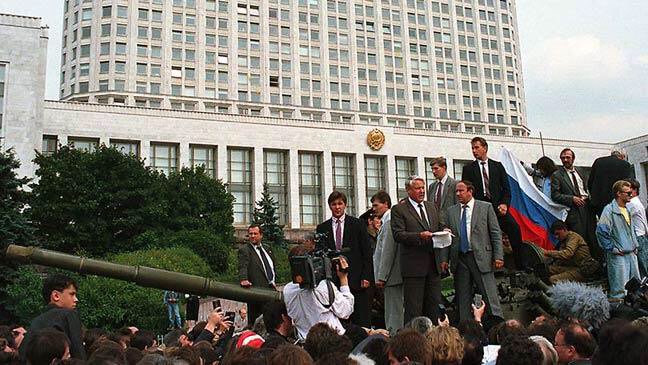
The Alpha Group and the Vympel Group integrated themselves into the crowds around White House ready to assassinate Yelsin and the pro-reform supporters. The leader of the operation was future Russian Federation Presidential candidate, future Yeltsin administration chairman of the Security Council, VDV Afghan War hero Alexander Lebed who reported that they could take control of the White House despite the presence of Evdokimov’s tank unit, but that there would be significant bloodshed. The coup plotters blinked.
On the evening of August 20th, Evdokimov’s tanks were ordered to leave the White House in order to give the Alpha Group and the Vympel Group free rein to arrest and/or kill the reformers including Yeltsin. Evdokimov’s tanks were gone…the door was wide open…the Alpha Group and the Vympel Group were onsite. Lebed gained fame by not following orders given to assassinate Yeltsin and eliminate or arrest the pro-reform forces occupying the White House. Too much time had past, the Yeltsin speech had taken hold of the imagination of too many of the Russian people. The coup plot collapsed in days with a doomed Gorbachev briefly returning to power and all coup plotters arrested or committing suicide by August 23, 1991.
The failed coup had the opposite effect that the coup plotters intended. Instead of preserving the central government‘s power, the result was the opposite and within months the complete dissolution of the Soviet Union had taken place. The “smartest guys” in the room, the “wizards of smart”, the “men of action” rolled to dice and got it all wrong.
An unfortunate side effect of this coup was the acknowledgement of a new political reality that the loyalty of specific elite military units was now required to remain in power in Russia. ut that was a problem for another day. But tomorrow always comes and this would have disastrous consequences for Russia in future.
Remember the names of the “Taman Guards” 2nd Guards Motor Rifle Division and Kantemir 4th Guards Tank Division as they are going to be important in Russia’s future in ways few people reading this will expect.
1993 October Coup
The opportunity for the 1993 October Coup or 1993 Russian constitutional crisis occurred in part due to public unhappiness with the fallout of Boris Yeltsin’s “shock therapy” economic reforms. This “shock therapy” resulted in inflation, credit constriction, skyrocketing unemployment, economic displacement, disrupted supplies of staple goods and a host of other social ills as Russia raced towards decentralization and a market economy. Once again this was a effectively a dispute between the reformers lead by Yeltsin and those who wanted something closer to the old Soviet Union back (on a smaller Russian only scale) represented by the Supreme Soviet and the Congress of People’s Deputies led by Alexander Rutskoy, Vice President of the Russian Federation. Yeltsin was impeached by the Congress of People’s Deputies. Yeltsin dissolved the Congress of People’s Deputies and dismissed Rutskoy as Vice President of Russia. Events travelled faster than the courts. Questionably capable Interior Ministry troops were in the streets supporting President Yeltsin attempting to restore some sort of order. Veterans, some quite capable combat veterans, supported Rutskoy and the Congress of People’s Deputies. People were dying in the streets at a rate in Moscow not seen since the 1917 Russian Revolution.
This time the Russian Army took only a few hours to decide whose side it was on. This time the Army came out squarely on the side of Yeltsin and the reformers. The most elite units of the Russian military, the Russian special operations Alpha Group and the Vympel Group and the conventional Army “Taman Guards” 2nd Guards Motor Rifle Division and Kantemir 4th Guards Tank Division were on Yeltsin and the reformers side. These elite units quickly secured the levers of power in Moscow save one.
This time the coup plotters took extra preparation is securing the very same White House where Yeltsin gave his famous tank speech” which launched his career into the stratosphere just 26 months earlier. The White House was now occupied by many experienced and heavily armed armed VDV (more on them is subsequent posts) veterans, many of whom had extensive Afghanistan combat experience. These men were prepared to fight against Yetlsin’s wild, destructive reforms and were a formidable obstacle to any Interior Ministry troops. This symbolic move by Rutskoy and the Congress of People’s Deputies was not lost on anyone, especially Yeltsin.
Yeltsin responded with a symbolic move of his own and on the on the 4th of October ordered tanks from the “Taman Guards” 2nd Guards Motor Rifle Division, to the White House . This was the same unit that rescued the reform government in the 1991 coup. At dawn, the “Taman Guards” 2nd Guards Motor Rifle Division, surrounded the White House. Within hours Taman Guards” tanks opened fire on the White House with 125mm main battery weapons (video). At noon Russia’s most elite special operation units, the Alpha Group and the Vympel Group, began a floor by floor clearing of the building. In the face of overwhelming firepower, the forces of the Congress of People’s Deputies and Vice President Rutskoy were mopped up. Rutskoy made a last minute appeal to the Russian Air Force to bomb the Kremlin (as if that would have made a difference) on the Echo of Moscow radio station. This request was ignored by the Russian Air Force and all it served to do was add a surreal, comic element to the ineptitude of the entire coup attempt.
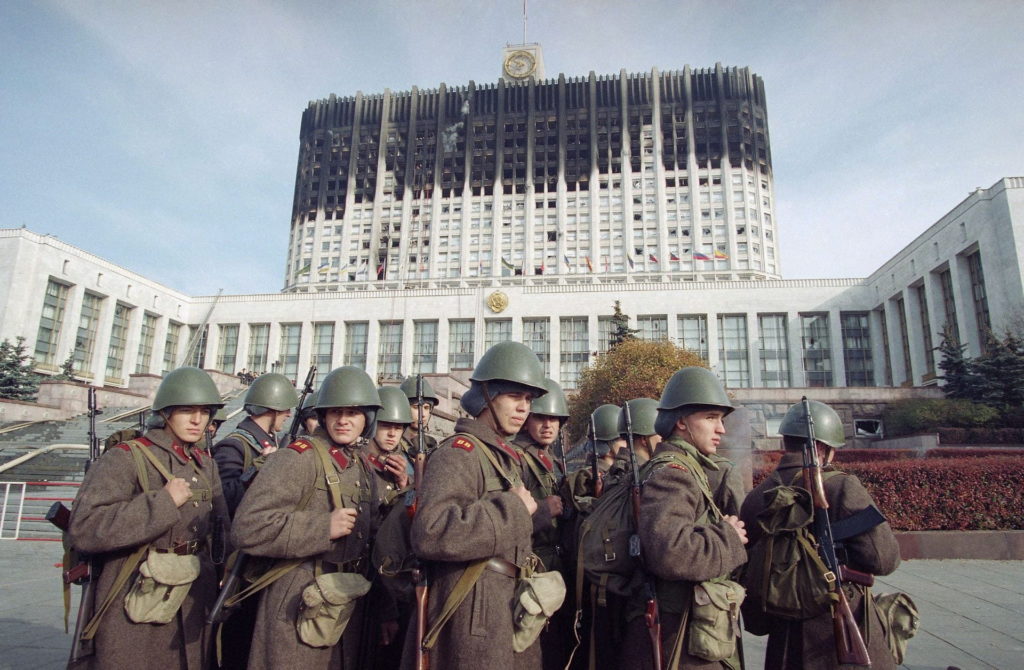
© AP / Shutterstock
The effect of the coup was bad for Russia in that people in Russia felt unsafe due to the use of force and increasingly unsafe over time as the support for Yeltsin’s use of force dropped significantly over time.
Due to the chaos, uncertainty and use of force, even more young Russian couples chose not to have children. The emigration rate which was dropping, plateaued as young Russian couples chose to live abroad, away from the coups, the tank fire, the calls on the radio for Russia’s own air force to bomb its own capitol building. Fewer children were born in the next decade in Russia. Fewer sons would be born to be of combat age in a war if it were to occur in 2022.
Once again, it was confirmed in the minds of many that in the post-Soviet Russian Federation the only way to hold on to political power was to have the loyalty of elite Russian military units. And when push came to shove, the special operators of the Alpha Group and the Vympel Group were certainly useful…but the heavy hitters of the “Taman Guards” 2nd Guards Motor Rifle Division and Kantemir 4th Guards Tank Division is where the real combat power lay to preserve a government. These were the two units that preserved a president or destroyed him in the post-soviet Russian Federation. It is easy to see why no one in power in the 1990s would want the “Taman Guards” 2nd Guards Motor Rifle Division or Kantemir 4th Guards Tank Division any further than an easy interventions distance from Moscow at all times. This was the political reality of the new Russian Federation. It was simply thought of as a temporary problem that would in effect solve itself. Unfortunately for the Russian Federation and Yeltsin, tomorrow came around much sooner than anyone thought and the results were going to be enormously costly and humiliating in both lives and treasure.
The “Unofficial Coup” of 1999
• Authors note: In this series I am going to intentionally avoid most “conspiracy theory” type discussions and focus on the what is readily provable or in some cases, I may mention something “inherently” unprovable if the belief in the theory has real world effects. While some facts of the “unofficial coup” are disputed, there is no question that there was a non-standard transfer of power in 1999. There is no doubt that apartment buildings were bombed. There is no doubt that a war was the result.
On 31 December 1999 an incredibly unpopular Boris Yeltsin resigned as of President of the Russian federation. Yeltsin’s replacement was political upstart Prime Minister and former KGB officer Vladimir Putin. A former KBG officer certainly was going to give some of the population reason to leave Russia all by itself. But the Putin presidency came with more than just KGB baggage. It came with a “terror campaign and a new highly unpopular war against an old enemy. The dreaded Chechens.
One of the reasons that Yeltsin was so unpopular was that the dreaded Chechens, the breakaway fighters in the Caucasus that had defeated Russia in the First Chechen War had apparently claimed responsibility for the bombings of four apartment buildings in Russia killing more than 300 people and injuring thousands of others in September of 1999
Yeltsin resigned on New Years Eve and Putin came into power January 1, 2000 promising a new war with Chechnya that would redress the loss of national pride resulting from the loss of the First Chechen War, provide vengeance for the dead from the first war and vengeance for the dead from the terror bombings at the same time. A bold plan that Russian nationalist found appealing. The tired, old, impotent drunk Yeltsin was out, the virile, strong, clever Putin was in.
The problem with the entire story was that the Chechens were the least likely people on the planet to have bombed Russian apartment buildings. The Chechens were successful in their war with Russia and effectively been grated all their demands with signing of the Treaty of Moscow in 1997. Chechens had nothing to gain and everything to lose with renewed hostilities with Russia. So why would they do it?
Here is the conspiracy part, they probably didn’t…
There is evidence that the bombings of the four apartment buildings in Russia that occurred in September 1999 were not the responsibility of the Chechens, but instead was the responsibility of the successor to the KGB…the Russian FSB. That the FSB, as the heirs to the KGB wanted to finally achieve the coups that they had previously attempted and failed in 1991 and 1993. I will not take one position or the other in this as the “truth” as is not critical to the point I am trying to make here.
That point is, whether this is true or not, the accusation (I leave you to determine the credibility) causes yet more uncertainty in the minds of the Russian public as to trust in their government and yields yet another disincentive to young mothers that affects the the birth rate in the late 1990s and early 2000s. If your government is willing to kill apartment buildings full of people and blame it on a minority population for political advantage…why have children in that country. Such a government could justify killing anyone for political advantage.
The First Chechen War and the Dismal 90s
There was this rather large war that was incredibly unpopular with a shocking course of action and an even more shocking conclusion for the Russian public called the First Chechen War. We will cover that in the next post entitled, “What if You Threw A War Party and the Cannon Fodder You Invited Don’t Want To Attend?”
A Funny Thing Happened On the Way to the War…the conclusion
Economics, government instability, political chaos, an unpopular and costly war, birth rates all lead to this critical data point.
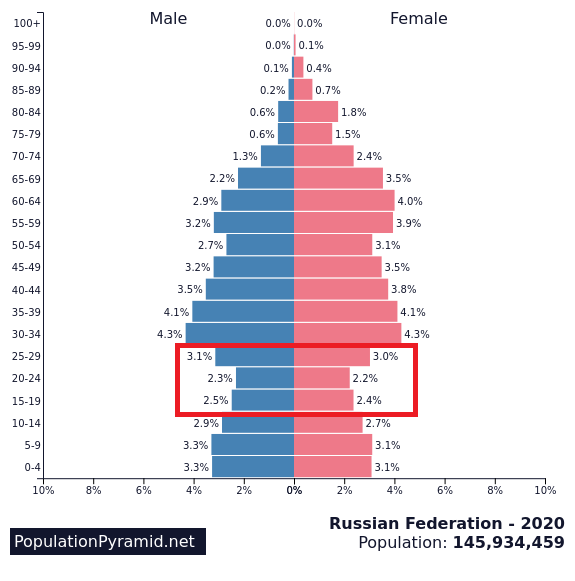
Source: populationpyramid.net
In 2022, Russia will have the smallest number of prime military age males in its history just as embarks on the largest military endeavor that the country has participated in since Word War II. This demographic fact will have profound effects on Russian strategy, force composition, force structure and societal resilience.
If demographics determines destiny, and there is strong evidence it does, Russia had some very careful choices to make in the face of this fact. Next we will learn about some of those effects and the choices Russian military planners had to make with The Russian-Ukrainian War, Part IV entitled “What if You Threw A War Party and the Cannon Fodder You Invited Don’t Want To Attend?”
Series Articles:
The Russian-Ukrainian War, a Series…
The Problem with the Donbas, The Russian-Ukrainian War, Part II
A Funny Thing Happened On the Way to the War, The Russian-Ukrainian War, Part III
The Russian-Ukrainian War, Part V, You Lose the War You Needed to Win to Survive…What’s next?